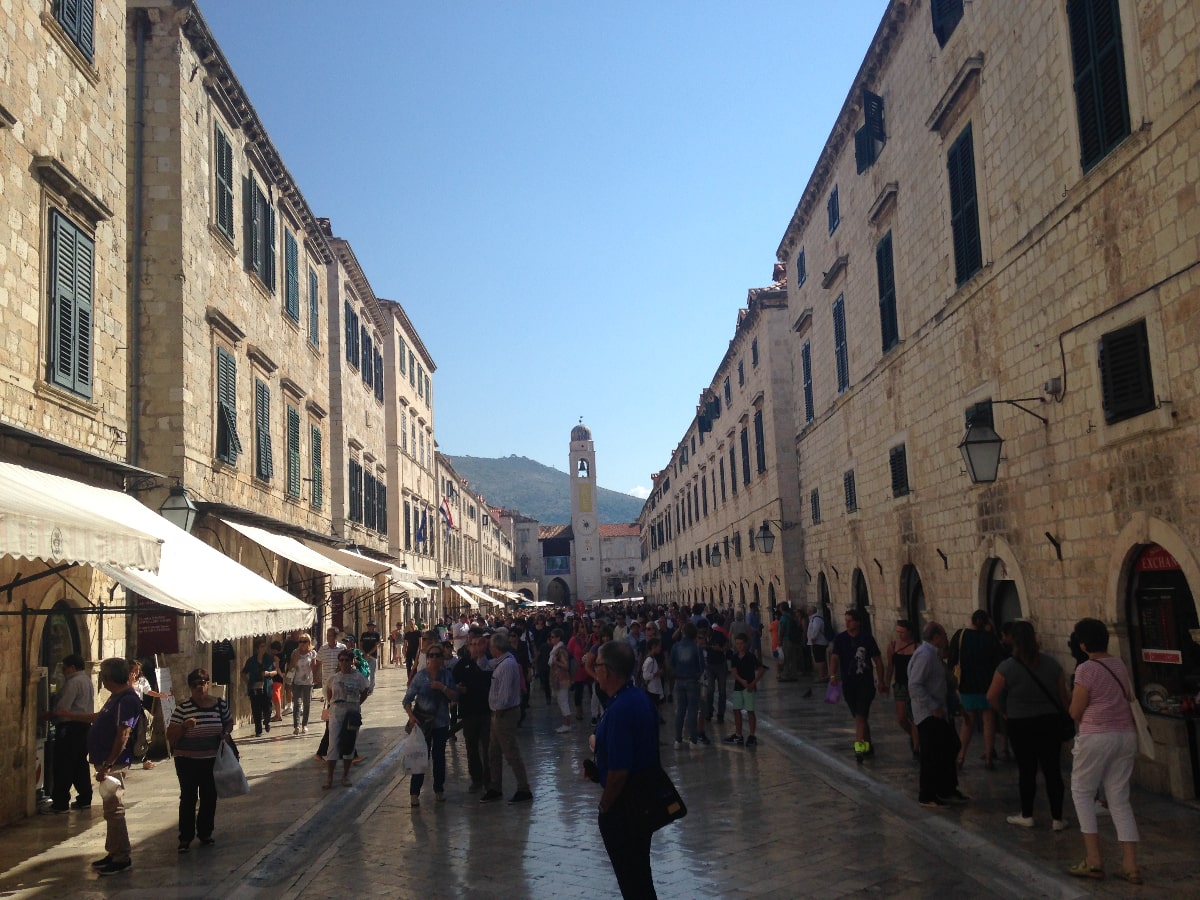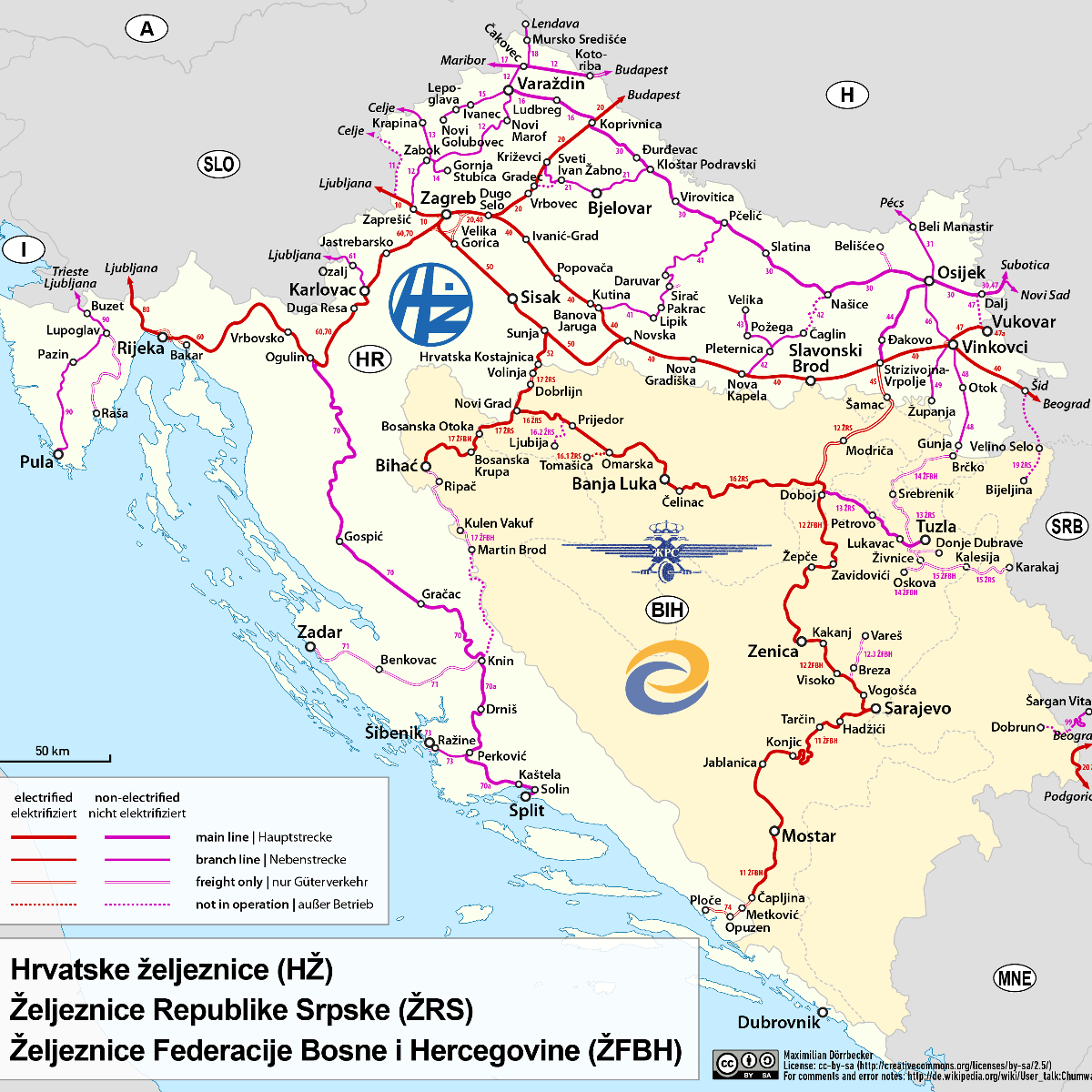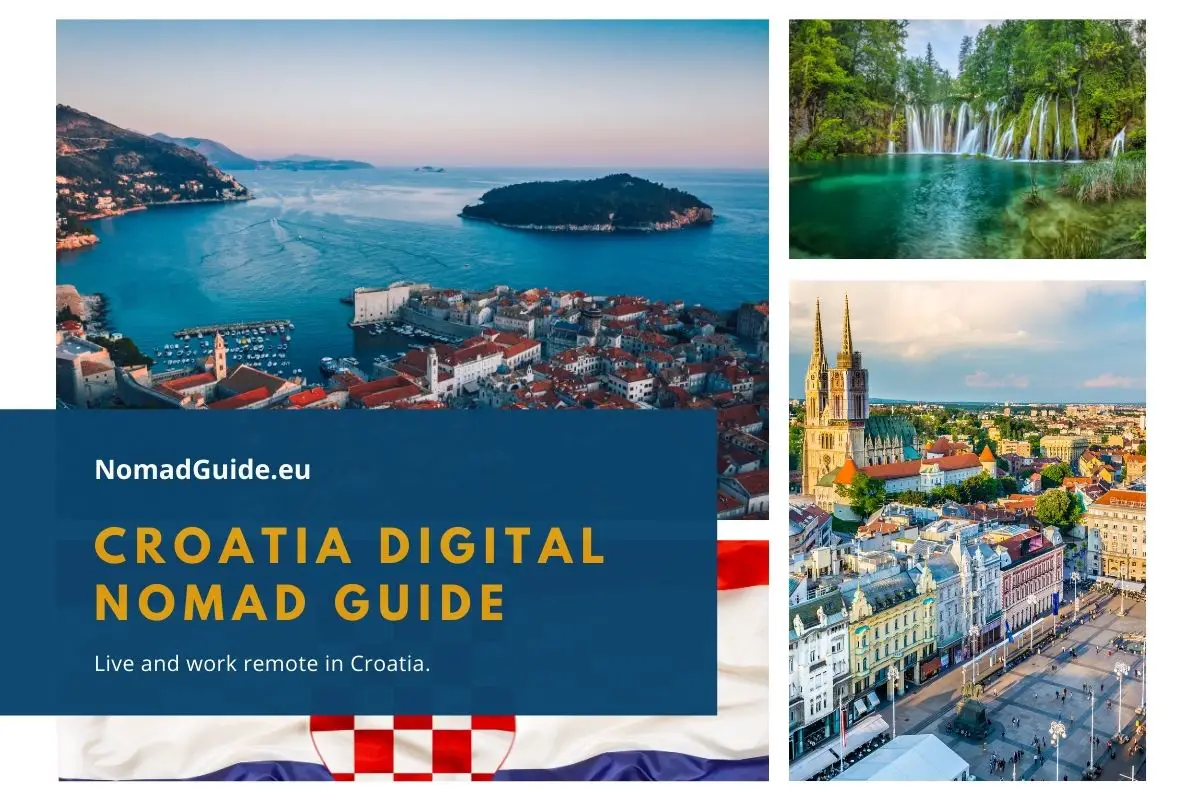Croatia today is something of a crossroads on the European continent. Since gaining independence following a bloody war in the 90’s, it has developed quicker than many of its neighbours and while it retains a Balkan identity, it also has plenty of common ground with many more established Central European countries. In this Croatia digital nomad guide, we’ll look at whether it is a good place to travel in whilst working remotely.
Table of Contents
Croatia Digital Nomad Guide

- Population – 4.1 million
- Capital – Zagreb
- Language – Croatian
- EU – Yes
- Schengen Area – No (expected to join soon, possibly in 2022)
- Currency – Croatian Kuna
Pros & Cons to being a Digital Nomad in Croatia
Advantages
- A Stunning Coastline
Croatia is a bit of an enigma in many respects. Look at a map of Europe and if you’re able to pick it out at all, it will only appear to be a small nation sandwiched between Italy and the rest of the Balkans. However, looks can be deceptive. Croatia’s coastline goes on and on, stretching for over 600 km from north to south.
The Adriatic Sea regions are certainly the jewel in the nation’s crown with many of the best towns and cities on the coast. It’s also safe to say that almost all digital nomads in Croatia opt to base themselves on the coast which is also home to three of the country’s five largest cities in the shape of Zadar, Split and Rijeka, as well as the ancient town of Dubrovnik, Croatia’s best known tourist destination.
- Quiet Island Life in Europe
Europe’s Mediterranean is full of well known Spanish, Italian and Greek islands but the most beautiful have long since become major travel destinations and particularly during the summer months, that inevitably leads to overcrowding and high prices. Those looking for something closer to unspoiled island life without leaving Europe need to get a bit more creative and the answer may just lie in Croatia.
The country’s territory takes in more than 1000 islands and islets, making it the second largest archipelago in the Med after the Greek archipelago. There are only 47 islands that are considered to be inhabited and many of them boast wonderful bays and beaches with crystal clear waters. Aside from lively Hvar, most are also pretty serene and relaxing places to spend some time.
- One of Europe’s best Digital Nomad Visas
Digital nomad visas are suddenly all the rage in Europe with a number of countries having introduced a scheme of some kind in the past twelve months. However if you read the smallprint, many are actually quite difficult to get on or have other significant disadvantages. Croatia though, not only was one of the first to offer a digital nomad visa, but it is also more accessible for many nomads with monthly earnings of 2250 Euros per month the minimum requirement to be eligible. That’s significantly less than in countries such as Estonia, Malta and Greece which also offer digital nomad visas. You can also get a Croatian digital nomad visa if you can demonstrate savings of 27000 Euros.
It’s also worth noting if you’re not looking for a long-term base, that for now at least, you can take advantage of Croatia’s status as a non-Schengen nation. If you’re approaching the end of your 90 day period inside the Schengen zone then Croatia is certainly a great option for resetting your clock whilst staying in a non-Schengen nation. However the Croatian government is hopeful of finally joining the bloc in 2022, although estimates suggest 2024 is a more realistic time-frame.
Disadvantages
- Limited Transport Infrastructure aside from Buses
For a young nation that has developed quickly and generally been successful since the turmoil of the 1990’s, Croatia’s transport system still leaves quite a bit to be desired. Getting between the capital Zagreb and the other main cities is usually relatively straight-forward although not particularly quick with the 400 km trip from Zagreb to Split taking around five hours by the fastest buses and more than six hours by rail. However unless you’re travelling to/from Zagreb, it can be much more frustrating with limited services connecting towns and cities along the long coastline and buses are pretty much your only option unless you rent a car.
Getting to and from other countries in the area can also be a real pain. Even though Croatia used to be part of the same country as neighbouring Bosnia, Serbia, Slovenia and Montenegro, there are few options in terms of international rail links. Therefore buses are usually the best option for crossing borders and that’s obviously not great for getting work done on the go, particularly with often lengthy border queues and checks a regular occurrence in the Balkans.
- Few Sandy Beaches
Seen as a big part of Croatia’s appeal with digital nomads relates to its sunny climate and coastal charms, it’s important to emphasise that does not necessarily mean it is an absolute beach lover’s paradise. That’s because most beaches in Croatia are pebbly and rocky and it’s main appeal comes from its dramatic, rugged cliffs and bays, along with the crystal clear waters.
Most regions do have a few sandy beaches too but they are harder to find and that’s something you should be aware of before jumping on the next plane to Croatia with dreams of Caribbean or Thai beaches in your mind.
Remote Work Croatia – Where to Go
For City Living by the Sea – Split
If you like big cities, then the only real option in Croatia is Zagreb which is over four times the size of the next biggest city, which is Split. However Zagreb has some notable disadvantages and is over 150 km from the coast, so most digital nomads seeking an urban experience in Croatia tend to favour Split.
With around 170,000 residents, it’s big enough to retain a lively feel and has plenty going on at night. It’s a stylish city with Greek and Venetian influences shaping its history and it has a pretty laid back feel to it. It also has an authenticity that is increasingly lacking in more touristic destinations, particularly Dubrovnik.
Split also has the significant advantage of being located close to a number of fantastic islands with regular connections from the city’s ferry terminal. Therefore you can enjoy the benefits of city living in the knowledge that an island getaway is always an easy option whether you want a bustling resort like Hvar or a more peaceful getaway.
For History, Natural Beauty & Overseas Adventures – Dubrovnik

Dubrovnik will divide opinions as to whether it’s one the best Croatian digital nomad destinations, but its beauty cannot be doubted. Its walled old town is one of the most impressive in Europe with some outstanding medieval architecture, the perfect contrast for the crystal clear waters of the Adriatic.
Prior to the pandemic, it used to get incredibly busy during July and August when thousands of tourists poured in each day and multiple cruise ships docked in its port. Mid-summer isn’t a great time to be a remote worker in the city but during the rest of the year, Dubrovnik is much quieter and accommodation is considerably cheaper.
Dubrovnik is also a really good location for anyone looking to do lots of extra trips to other countries in the region, or around Europe. It is located in a tiny Croatian enclave, surrounded mostly by Bosnia-Herzegovina aside from a small section which forms a border with Montenegro. Those two countries are therefore easy to reach in less than an hour while it’s also the Croatian city with by far the best links to Albania, Kosovo, North Macedonia and Greece. You can even take a daily ferry (during peak times) to the Italian city of Bari from Dubrovnik while the city’s status as a major tourist destination ensures there are lots of budget flights to other parts of the continent.
For Croatia’s first Digital Nomad Village – Zadar
Barely a month goes by these days where you don’t hear about some kind of plans for new digital nomad villages or settlements. Realistically, it’s likely that many are simply not going to take off and won’t deliver on their ambitious objectives but the concept is a fascinating one and if you fancy checking one out for yourself, consider heading to the Digital Nomad Valley Zadar!
Zadar is another sunny, port town, situated roughly in the middle of Croatia’s Adriatic coastline, north of Split but south of Rijeka, the country’s third largest city. This Croatian digital nomad village will consist of a site of around 25 hectares where nomads can live and work together.
Exact details are relatively sketchy at the moment but the ambition is for it to play a role in turning Croatia into one of Europe’s primary digital nomad hubs, something that the government is also seemingly keen on.
Croatia Digital Nomad Tips
Getting Around Croatia
As mentioned previously, Croatia is a deceptively large country with some relatively long distances involved for getting from A to B. It’s not so large that there is any real need for domestic flights (there are a few routes to/from Zagreb) but it’s not a country where you can get anywhere you need in the space of a couple of hours so prepare for some long journeys.
By Bus – Unless you have a private vehicle, getting around Croatia is usually best done by bus. Every town, no matter how big or small, seems to have a bus station with regular departures to nearby towns and usually a few long-distance options each day. Fares are reasonably good value with the 400 km Zagreb-Split trip usually costing around 150 Kuna (20 Euros) for example. Most regional connections are considerably cheaper. You can find out about bus timetables in Croatia here.
By Train – Croatia isn’t a brilliant country for rail travel as most of the lines haven’t been modernised since the first half of the 20th Century. As a result maximum speeds of just 80 km/hr are common across much of the network. Most of the rail services are found in the inland areas, stemming from Zagreb. There are passenger services from Zagreb to Split and Rijeka, however most coastal towns, including Dubrovnik, do not have any rail links. There are also limited rail connections with Slovenia, Hungary, Bosnia and Herzegovina and Serbia but international trips are also usually quicker by bus.

By Boat – Almost all of Croatia’s inhabited islands have some kind of ferry service connecting them with major ports on the mainland. Split is close to several of the main islands and has the highest number of connections. There is even a Catamaran service running between April and October from Split to Dubrovnik, via some of the islands, with the full journey taking around 4 hours 30 minutes. You can also take the ferry across the Adriatic from a number of Croatian cities with services to the Italian cities of Bari, Ancona and Venice amongst others. Check out our Italy digital nomad guide for more on remote working from there.
Finding Accommodation
Airbnb is generally fine for all your short to mid-term accommodation needs in Croatia. Prices are generally pretty good by the standards of most Western and Central European countries although you will still notice a significant hike if you’re coming from most other Balkan or former Yugoslav nations like Montenegro or Bosnia.
There are also major seasonal swings in coastal areas and you’re probably best booking in advance if you’re coming during the peak summer months of July and August. During the winter you should be able to find some excellent deals and major discounts on monthly stays.
Coworking Croatia & Other Places to Work
As a country that is seemingly keen to embrace the remote working lifestyle and attract digital nomads from far and wide, Croatia does have plenty of options for coworking. Here’s a very small sample of some of the best reviewed coworking spaces in Croatia for anyone planning to be a digital nomad in 2022 or beyond.
| Saltwater Nomads, Multiple Locations | Saltwater has both coworking spaces and accommodation for digital nomads in Croatia. There’s even a beach office in Split during the summer! |
| COIN Coworking, Zadar | A popular option in the Adriatic town of Zadar with high-speed wifi and lots of office and deskspace plus use of the kitchen and living room. |
| The Works, Split | A 24/7 coworking space in Split featuring excellent facilities including an in-house gym and a lounge area with a gaming station. |

